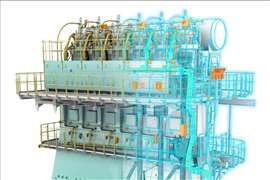EPA, DOT Finalize Heavy-Duty Truck GHG, Fuel Efficiency Standards
16 August 2016
The U.S. Environmental Protection Agency (EPA) and the U.S. Dept. of Transportation’s (DOT’s) National Highway Traffic Safety Administration (NHTSA) jointly finalized standards for medium- and heavy-duty vehicles intended to improve fuel efficiency and cut carbon pollution while bolstering energy security and spurring manufacturing innovation.
The final phase two standards promote a new generation of cleaner, more fuel-efficient trucks by encouraging the wider application of currently available technologies and the development of new and advanced cost-effective technologies through model year 2027, EPA and NHTSA said. They are expected to lower carbon dioxide (CO2) emissions by approximately 1.1 billion metric tons, save vehicle owners fuel costs of about $170 billion and reduce oil consumption by up to two billion barrels over the lifetime of the vehicles sold under the program, the agencies said.
The product of four years of extensive testing, research and outreach to industry, environmental organizations, labor unions and other stakeholders, the standards will cover model years 2021 to 2027 and apply to semi-trucks, large pickup trucks and vans and all types and sizes of buses and work trucks, EPA and NHTSA said, resulting in significant greenhouse gas (GHG) emissions reductions and fuel efficiency improvements across all of these vehicle types. For example, when the standards are fully phased in, tractors in a tractor-trailer will achieve up to 25% lower CO2 emissions and fuel consumption than an equivalent tractor in 2018, the agencies said.
Compared to the proposal, the final program:
- Achieves 10 percent more GHG and fuel consumption reductions;
- Has more robust compliance provisions, including improved test procedures, enhanced enforcement audits and protection against defeat devices;
- Includes more stringent diesel engine standards
- Improves the vocational vehicle program with a regulatory structure better tailored to match the right technology for the job;
- Maintains the structure and incremental phase-in of the proposed standards, allowing manufacturers to choose their own technology mix and giving them the lead time needed to ensure those technologies are reliable and durable.
NHTSA and EPA said they worked together to harmonize their standards under this program. The agencies worked closely with the state of California’s Air Resources Board (CARB) in developing and finalizing the standards.
For more details on the DOT’s and EPA’s phase two greenhouse gas emissions and fuel efficiency standards for medium- and heavy-duty vehicles, visit www3.epa.gov/otaq/climate/regs-heavy-duty.htm and www.nhtsa.gov/fuel-economy.
POWER SOURCING GUIDE
The trusted reference and buyer’s guide for 83 years
The original “desktop search engine,” guiding nearly 10,000 users in more than 90 countries it is the primary reference for specifications and details on all the components that go into engine systems.
Visit Now
STAY CONNECTED




Receive the information you need when you need it through our world-leading magazines, newsletters and daily briefings.
CONNECT WITH THE TEAM












